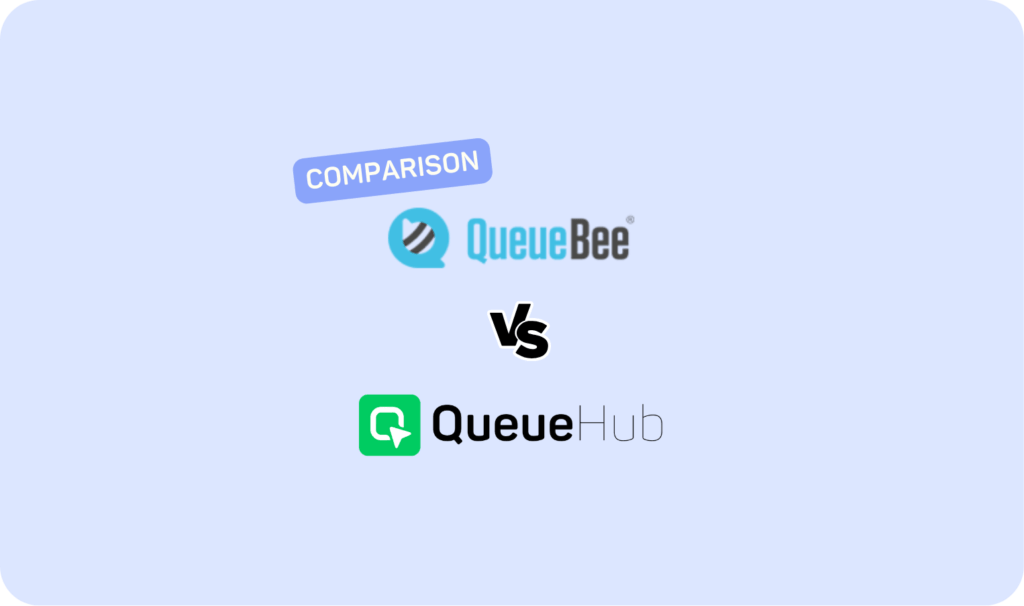QueueBee vs QueueHub: Best Queue Management System Comparison for Malaysia

An efficient queue management system (QMS) can be the difference between satisfied, loyal customers and frustrated ones. For businesses in Malaysia, whether it’s a small clinic, shopping mall, or a government agency, a well-designed queue management system can streamline service, boost productivity, and enhance the customer experience.
Among popular Queue management systems in Malaysia, QueueBee and QueueHub are two of the leaders in the market, each with its own set of features, advantages, and challenges. In this article, we’ll explore the main differences between QueueBee and QueueHub. We will explore if QueueHub is a good QueueBee alternative and present a brief review, So businesses can make an informed choice.
1. Overview of QueueBee and QueueHub
QueueBee
QueueBee is a well known QMS that combines digital and physical queue solutions, catering to small to medium-sized businesses as well as multi-department setups. It offers an impressive range of features like Physical and Virtual Queue Management, Online Appointment Scheduling, Customer Feedback, Dashboard & Analytics, and Video Chat.
With specialized systems designed to accommodate both single-counter environments and complex multi-service businesses, QueueBee is popular among healthcare clinics, service centers, and even large corporations and government agencies.
QueueHub
QueueHub, on the other hand, is a newer yet rising competitor in the Malaysian queue management market. It provides a straightforward yet comprehensive set of features, designed to optimize queue efficiency at an affordable price. This affordability makes it an appealing option for small and medium-sized businesses, particularly in Malaysia, where many businesses operate with limited budgets for tech solutions.
QueueHub is also highly scalable, allowing businesses to expand the system as needed, making it a flexible solution for a range of industries from retail and clinics to government offices.
2. Comparing Features: QueueBee vs QueueHub
| Feature | QueueBee | QueueHub |
|---|---|---|
| إدارة الطوابير | Physical and virtual queue solutions tailored to specific business types | Integrated physical and virtual queuing that scales easily from single location to multi-branch |
| Online Appointment | Fully-featured, with options for appointment reminders | Simplified, easy to use, and more cost-effective |
| Customer Feedback | Available, optional feature | Feedback option integrated at no extra cost |
| Content Management | Centralized dashboard for content management across branches | Allows customized content with seamless integration |
| Customer Web Portal | Offers a range of options but can be costlier | Straightforward, more user friendly web dashboard for easy customer engagement |
| Mobile App | QueueBee app enables users to check wait times and manage appointments | QueueHub is a Web based QMS |
| Hardware Compatibility | Wide hardware compatibility but often requires QueueBee hardware for full functionality | Compatible with various third-party hardware options |
| Reporting & Analytics | In-depth reporting and analytics capabilities | Detailed reporting and analytics capabilities that anyone can use easily |
| Third-Party Integrations | Well-suited for integration with other software systems | Seamless integration options with our team’s assistance |
3. Cost-Effectiveness and Affordability
One of QueueHub’s key selling points is affordability. Unlike QueueBee, which provides a range of advanced features at a higher price point, QueueHub prioritizes essential QMS features while keeping costs low. For small to medium-sized businesses in Malaysia, QueueHub can be an attractive solution, delivering the core functions necessary to reduce wait times and manage appointments without stretching budgets.
For businesses looking to keep setup and maintenance costs to a minimum, QueueHub also offers compatibility with a wide range of hardware, whereas QueueBee often requires its proprietary hardware for optimum performance. This open compatibility in QueueHub makes it a highly accessible QueueBee alternative for businesses that want flexibility in the equipment they use, reducing initial investment costs.
4. Scalability and Suitability for Multiple Branches
Both QueueBee and QueueHub are designed to support growth. QueueBee, however, leans towards serving larger organizations or multiple branches through its Corporate Centralised Queue system, which consolidates management and reporting across multiple locations using QueueBee solutions like QB10 and QB20. This centralized platform is excellent for established corporations but may be overkill for smaller businesses or startups.
In contrast, QueueHub allows businesses to scale without such rigid constraints, making it ideal for small and medium-sized enterprises (SMEs) with plans for growth. QueueHub’s scalable nature also keeps operational costs low as the business expands, making it highly suitable for businesses across Malaysia that may have ambitions to open new branches in the future.
5. User Experience and Accessibility
For businesses looking to enhance customer experience and reduce perceived wait times, QueueHub’s straightforward user interface shines. QueueHub’s mobile app, customer web portal, and online booking features are designed to be easy to navigate for both staff and customers. Its flexibility in integration allows businesses to maintain control over the customer journey while keeping the system intuitive and accessible for all users.
QueueBee also provides a robust user experience with advanced options, yet its features may feel overwhelming for businesses that don’t need extensive configuration. For organizations that do require specialized configurations, QueueBee remains an excellent choice, but QueueHub may appeal more to businesses preferring a simpler and more user-friendly interface at a lower cost.
6. Analytics and Reporting: QueueHub’s Edge
Both QueueBee and QueueHub offer detailed reporting tools, but QueueHub has worked hard to create dynamic reporting features that offer comprehensive insights without the complexity. QueueHub’s analytics dashboard can track real-time queue status, customer engagement metrics, and branch performance in a digestible format. This accessibility and ease of use make it a great choice for Malaysian businesses aiming to stay data-driven without the overhead of extensive analytics tools.
Conclusion: Which Queue Management System is Best for Malaysia?
When comparing QueueBee and QueueHub for Malaysian businesses, it becomes clear that each system has strengths tailored to different types of organizations. QueueBee is a robust system with extensive features that are ideal for large enterprises, government sectors, or any business that requires a multi-department, multi-branch queue management system. Its comprehensive options, however, come with a higher price tag, which may deter smaller businesses.
QueueHub, on the other hand, excels as an affordable, scalable, and user-friendly option making it a perfect QueueBee alternative, suitable for small to medium-sized enterprises looking to improve queue efficiency without the complexity and cost of advanced features. For businesses in Malaysia seeking a cost-effective yet flexible QMS solution, QueueHub’s simplicity, compatibility with third-party hardware, and budget-friendly nature make it a top contender.
Ultimately, the choice between QueueBee and QueueHub depends on the specific needs and scale of the business. For smaller Malaysian businesses aiming for a powerful yet affordable QMS, QueueHub offers an ideal balance between functionality and affordability. Large corporations and organizations requiring more specialized configurations may still find QueueBee worth the investment.




